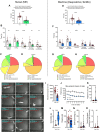Effects of ketamine on rat social behavior as analyzed by DeepLabCut and SimBA deep learning algorithms
- PMID: 38269275
- PMCID: PMC10806163
- DOI: 10.3389/fphar.2023.1329424
Effects of ketamine on rat social behavior as analyzed by DeepLabCut and SimBA deep learning algorithms
Abstract
Traditional methods of rat social behavior assessment are extremely time-consuming and susceptible to the subjective biases. In contrast, novel digital techniques allow for rapid and objective measurements. This study sought to assess the feasibility of implementing a digital workflow to compare the effects of (R,S)-ketamine and a veterinary ketamine preparation Vetoquinol (both at 20 mg/kg) on the social behaviors of rat pairs. Historical and novel videos were used to train the DeepLabCut neural network. The numerical data generated by DeepLabCut from 14 video samples, representing various body parts in time and space were subjected to the Simple Behavioral Analysis (SimBA) toolkit, to build classifiers for 12 distinct social and non-social behaviors. To validate the workflow, previously annotated by the trained observer historical videos were analyzed with SimBA classifiers, and regression analysis of the total time of social interactions yielded R 2 = 0.75, slope 1.04; p < 0.001 (N = 101). Remarkable similarities between human and computer annotations allowed for using the digital workflow to analyze 24 novel videos of rats treated with vehicle and ketamine preparations. Digital workflow revealed similarities in the reduction of social behavior by both compounds, and no substantial differences between them. However, the digital workflow also demonstrated ketamine-induced increases in self-grooming, increased transitions from social contacts to self-grooming, and no effects on adjacent lying time. This study confirms and extends the utility of deep learning in analyzing rat social behavior and highlights its efficiency and objectivity. It provides a faster and objective alternative to human workflow.
Keywords: DeepLabCut; EQIPD quality system; NMDA receptor antagonist; SimBA; ethology.
Copyright © 2024 Popik, Cyrano, Piotrowska, Holuj, Golebiowska, Malikowska-Racia, Potasiewicz and Nikiforuk.
Conflict of interest statement
The authors declare that the research was conducted in the absence of any commercial or financial relationships that could be construed as a potential conflict of interest.
Figures




Similar articles
-
Comprehensive ethological analysis of fear expression in rats using DeepLabCut and SimBA machine learning model.Front Behav Neurosci. 2024 Aug 1;18:1440601. doi: 10.3389/fnbeh.2024.1440601. eCollection 2024. Front Behav Neurosci. 2024. PMID: 39148895 Free PMC article.
-
Deep learning algorithms reveal increased social activity in rats at the onset of the dark phase of the light/dark cycle.PLoS One. 2024 Nov 8;19(11):e0307794. doi: 10.1371/journal.pone.0307794. eCollection 2024. PLoS One. 2024. PMID: 39514582 Free PMC article.
-
Analysis of Operant Self-administration Behaviors with Supervised Machine Learning: Protocol for Video Acquisition and Pose Estimation Analysis Using DeepLabCut and Simple Behavioral Analysis.eNeuro. 2025 Feb 6;12(2):ENEURO.0031-24.2024. doi: 10.1523/ENEURO.0031-24.2024. Print 2025 Feb. eNeuro. 2025. PMID: 39774006 Free PMC article.
-
A methodology for the annotation of surgical videos for supervised machine learning applications.Int J Comput Assist Radiol Surg. 2023 Sep;18(9):1673-1678. doi: 10.1007/s11548-023-02923-0. Epub 2023 May 28. Int J Comput Assist Radiol Surg. 2023. PMID: 37245179 Review.
-
Keeping it simple - a Simple Behavioral Analysis (SimBA) primer.NPP Digit Psychiatry Neurosci. 2024;2(1):13. doi: 10.1038/s44277-024-00014-9. Epub 2024 Aug 2. NPP Digit Psychiatry Neurosci. 2024. PMID: 39099890 Free PMC article. Review. No abstract available.
Cited by
-
Fasting-induced activity changes in MC3R neurons of the paraventricular nucleus of the thalamus.Life Sci Alliance. 2024 Aug 6;7(10):e202402754. doi: 10.26508/lsa.202402754. Print 2024 Oct. Life Sci Alliance. 2024. PMID: 39107065 Free PMC article.
-
Rapid, open-source, and automated quantification of the head twitch response in C57BL/6J mice using DeepLabCut and Simple Behavioral Analysis.bioRxiv [Preprint]. 2025 Jul 16:2025.04.28.650242. doi: 10.1101/2025.04.28.650242. bioRxiv. 2025. Update in: ACS Pharmacol Transl Sci. 2025 Jul 31;8(8):2694-2709. doi: 10.1021/acsptsci.5c00305. PMID: 40568111 Free PMC article. Updated. Preprint.
-
Assessing the effects of 5-HT2A and 5-HT5A receptor antagonists on DOI-induced head-twitch response in male rats using marker-less deep learning algorithms.Pharmacol Rep. 2025 Feb;77(1):135-144. doi: 10.1007/s43440-024-00679-1. Epub 2024 Nov 27. Pharmacol Rep. 2025. PMID: 39602080 Free PMC article.
-
Comprehensive ethological analysis of fear expression in rats using DeepLabCut and SimBA machine learning model.Front Behav Neurosci. 2024 Aug 1;18:1440601. doi: 10.3389/fnbeh.2024.1440601. eCollection 2024. Front Behav Neurosci. 2024. PMID: 39148895 Free PMC article.
-
Deep learning algorithms reveal increased social activity in rats at the onset of the dark phase of the light/dark cycle.PLoS One. 2024 Nov 8;19(11):e0307794. doi: 10.1371/journal.pone.0307794. eCollection 2024. PLoS One. 2024. PMID: 39514582 Free PMC article.
References
-
- Ando R. D., Benko A., Ferrington L., Kirilly E., Kelly P. A., Bagdy G. (2006). Partial lesion of the serotonergic system by a single dose of MDMA results in behavioural disinhibition and enhances acute MDMA-induced social behaviour on the social interaction test. Neuropharmacology 50, 884–896. 10.1016/j.neuropharm.2005.12.010 - DOI - PubMed
-
- Barnett S. A. (1958). An analysis of social behaviour in wild rats. Proc. Zoological Soc. Lond. 130, 107–152. 10.1111/j.1096-3642.1958.tb00565.x - DOI
-
- Barnett S. A. (2001). The story of rats: their impact on us, and our impact on them. Nest, NSW, Australia, Crows Nest, NSW, Australia: Allen & Unwin Crows.
LinkOut - more resources
Full Text Sources

